Palace of Versailles Gardens
The Gardens, Orangery, Fountains, Sculptures & Statues
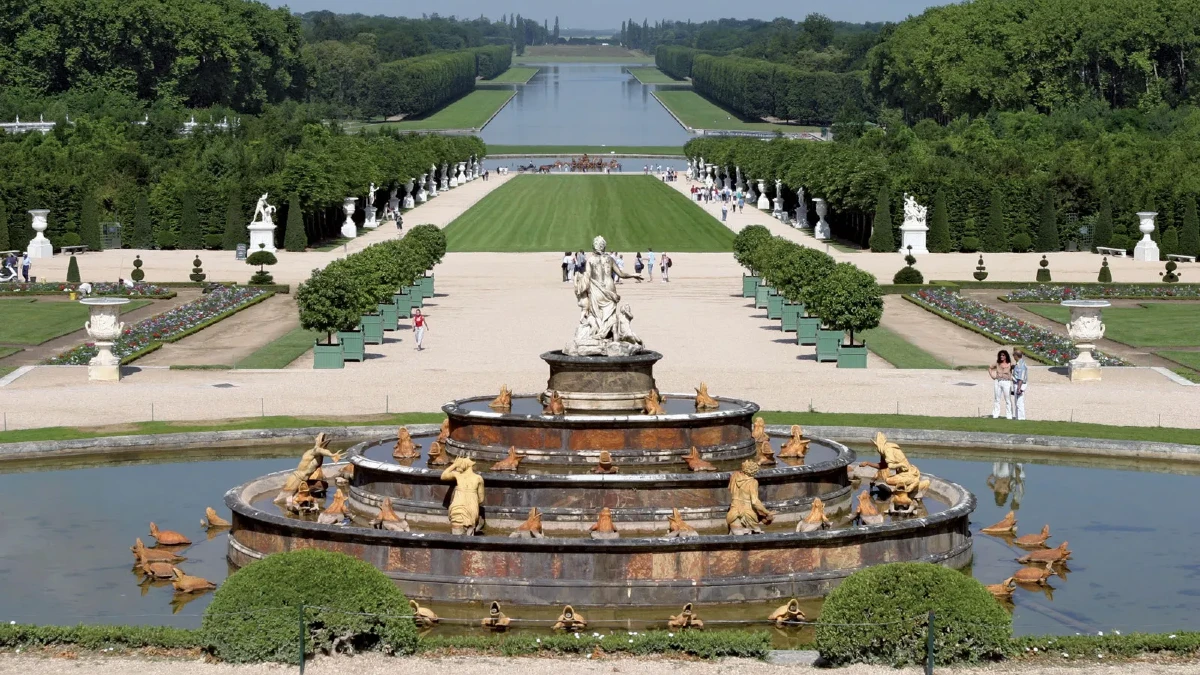
The Versailles Gardens cover nearly 2,014 acres and feature 50 fountains, 620 water jets, and hundreds of sculptures and statues.
To reach the Versailles Gardens, enter through the Honor Gate, head to the left side of the Honor Courtyard, and finally enter through the Princes Courtyard Gate.
The Gardens open at 8 am all year round. From April to October (the high season), they close at 8:30 pm. From November to March (the low season), they close at 6 pm.
On special event days, including Night Fountains Show days, the Gardens close at 5:30 pm.
Here’s what you can expect from these historic Gardens.
The Palace of Versailles gets over 8 million visitors each year, so it’s best to book early. The Full Access Ticket lets you explore on your own, the Guided Tour offers expert insights, and the Transport Tour makes it easy with pickup from Paris.
Versailles Gardens
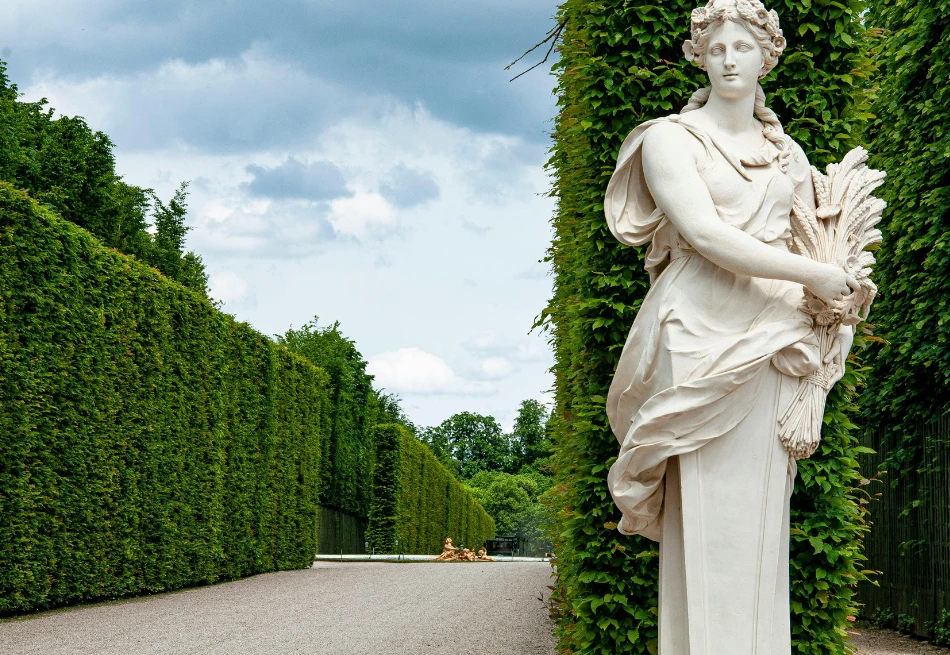
The Gardens have about 200,000 trees and 210,000 flowers. The French-style garden includes groves, pathways, and beautifully designed flower beds.
The landscape is stunning during musical and night fountain shows, with illuminated water jets and fountains moving in sync with Baroque music.
The stunning Versailles Gardens are a masterpiece created by French architect André Le Nôtre.
Louis XIV initiated the creation of the Gardens in 1661, and the monumental project commenced immediately. It took 40 years to finish.
Thousands of men and women worked on the construction, and sometimes even military regiments were involved.
The trees and plants are replanted every 100 years to keep the Gardens healthy and beautiful.
The Orangery
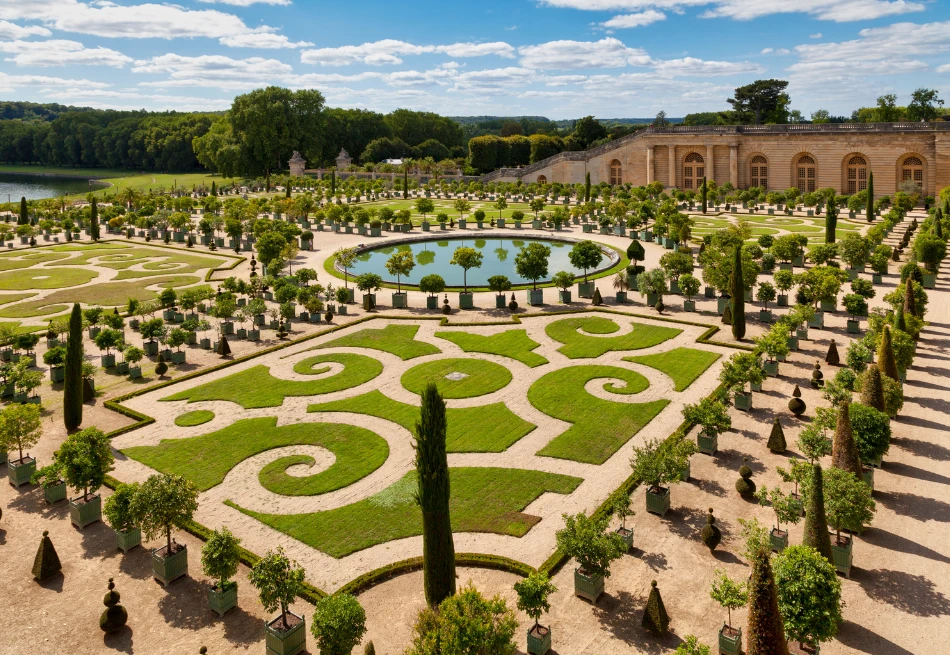
In the 17th century, orangeries were a status symbol for European palaces and a practical solution to protect citrus trees during harsh winters.
Nearly every palace had an orangery, and Versailles is no exception!
The Versailles Orangery is 150 meters long and houses around 1,500 trees. It has a 13-meter-high vaulted ceiling and 4 to 5-meter-high walls to keep the trees warm.
Designed by architect Jules Hardouin-Mansart, it is home to nearly 200-year-old trees, including orange, lemon, oleander, palm, and pomegranate trees.
It is one of the largest orangeries in Europe.
Parterres and Paths
The Versailles Gardens have four main parterres: South Parterre, North Parterre, Water Parterre, and Latona Parterre.
The South Parterre features two impressive bronze sphinx statues and offers stunning views of the Orangery.
The North Parterre is marked by two bronze statues and is divided into two sections, each with a circular pool at its center.
The Water Parterre has two large rectangular pools that reflect the Hall of Mirrors, creating beautiful scenes of light and shadow.
From the steps of Latona’s Fountain, you can see a grand perspective of the Gardens and the Palace.
Recently, in 2015, the Latona Parterre was restored to its original design after being turned into a lawn during the French Revolution. It now covers nearly 3.5 hectares with flower beds and patterns from the 1660s.
Book your Versailles Guided Tour with Gardens Access now! Experience hassle-free, skip-the-line entry to both the magnificent palace and stunning gardens.
Versailles Fountains
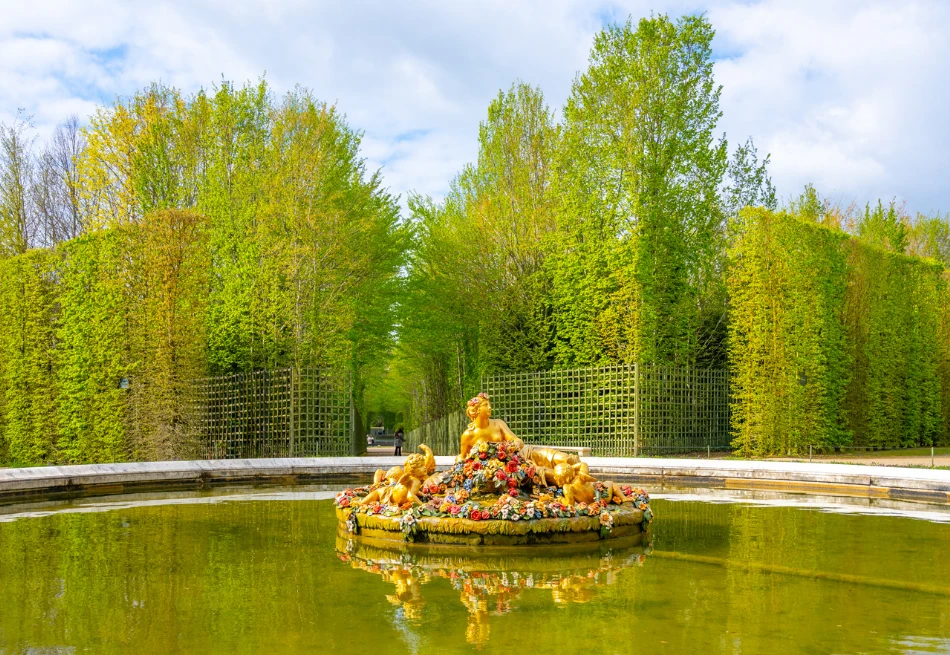
The Palace of Versailles Gardens boasts some of the world’s most iconic fountains. Here are some of the popular fountains and their significance.
The Four Seasons Fountains
The Four Seasons Fountains in Versailles Gardens represent Spring, Summer, Autumn, and Winter.
To the north, you’ll find the Spring Fountain, also known as the Flora Fountain (1674), and the Summer Fountain, or Ceres Fountain (1673).
To the south are the Autumn Fountain, also called the Bacchus Fountain (1674), and the Winter Fountain, or Saturn Fountain (1677).
From the viewpoint at the end of Latona’s Parterre and the entrance to the Royal Way, you can admire all four fountains simultaneously.
The Latona’s Fountain
Here is the short story of Latona’s Fountain!
Latona, the mother of the gods Diana and Apollo, pleaded with Jupiter to avenge the peasants of Lycia who had insulted her children.
In response, Jupiter transformed the peasants into frogs and lizards, a tale known as Ovid’s Metamorphoses.
The Latona’s Fountain was built based on this myth.
Neptune Fountain
Originally named ‘Lake Below the Dragon’ or ‘Lake of the Pines, ‘ the Neptune Fountain was constructed between 1679 and 1681.
It has an extraordinary hydraulic system with 99 water jets in this fountain.
Apollo’s Fountain
The gilded Apollo’s Fountain is based on the legend of the Sun god Apollo and the King’s icon.
The water feature is known as the Lake of the Swans and has existed since 1636.
It depicts the god emerging from the water, ready for his daily journey across the sky.
Mirror Pool
Louis XIV commissioned the Mirror Pool in 1702, opposite the King’s Garden.
You will witness the two pools separated by an alley and five paths leading to the pool.
Nymphs’ Bath
This pool, also called Diana’s Nymphs’ Bath, collects water from the Pyramid Fountain.
It is decorated with bas-reliefs, the most famous by François Girardon from 1668-1670, made of lead and originally gilded.
The fountain gets its name from Girardon’s central bas-relief, Nymphs’ Bath, which shows female nature divinities playing among reeds, based on a drawing by Charles Le Brun.
Explore various tour options in Versailles, including the Full-access ticket with gardens, Skip-the-line guided tour, Round-trip palace tour from Paris, Night fountains show ticket, Versailles Palace Bike Tour and Private golf cart tour of the palace – perfect for every visitor’s needs.
Sculptures and Statues
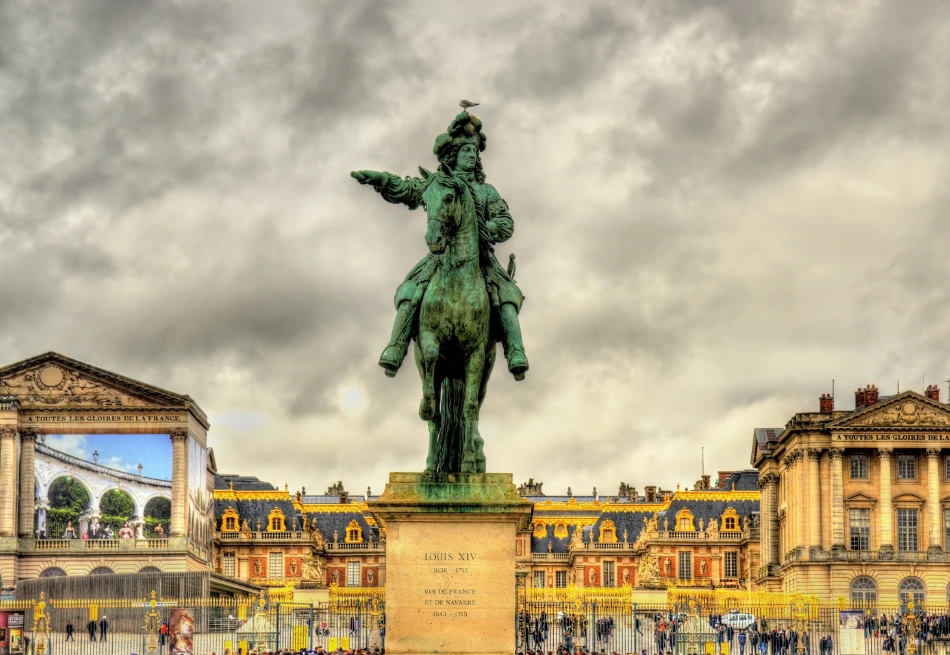
Versailles has 386 sculptures and 400 statues, making it the largest open-air sculpture museum in the world.
These sculptures, made of bronze, marble, and lead, were created at different times, though the exact timeline is still unknown.
The first set of sculptures were made in the 1660s. Early on, many sculptures and statues represented Apollo, the Sun God, and natural elements.
Art historians consider the 1674 Great Commission, a set of sculpture works, a milestone in Versailles’ marble art.
Created by the best sculptors, these works are among the finest in French history.
Groves
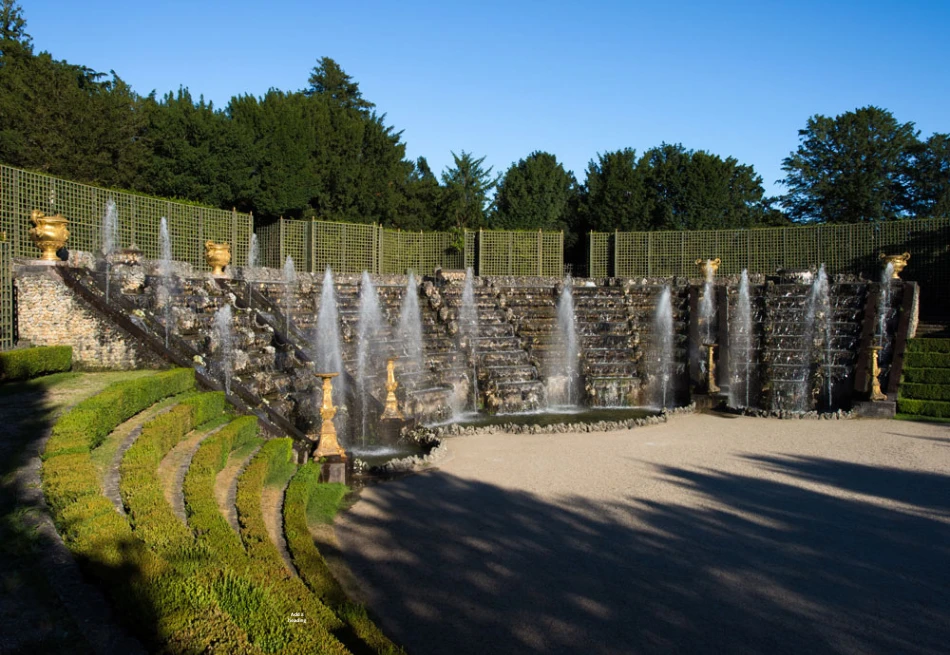
The groves in Versailles Gardens are filled with fountains, vases, and statues, and the kings enjoyed walking along these paths.
In the early years of Louis XIV’s reign, there were fifteen groves. However, over time, some have deteriorated or been destroyed, including the famous Labyrinth, which was removed in 1776.
Today, 13 groves are divided into the Southern and Northern Groves.
The Southern Groves include Queen’s Grove, Ballroom Grove, Girandole Grove, Colonnade Grove, and Chestnut Room (Water Gallery).
The Northern Groves are Grove of the Domes, Enceladus Grove, Obelisk Grove, Apollo’s Baths Grove, Star Grove, Water Theatre Grove, Grove of the Three Fountains, and Triumphal Arch Grove.
Frequently Added Questions
Here are some of the frequently asked questions about Versailles Gardens.
Which ticket should I book to visit Versailles Gardens?
The Versailles Palace and Gardens Full Access ticket provides you with one-day access to all the attractions, which includes the Gardens. It costs €32.
If you prefer guided tours, book this Skip-The-Line Guided Tour, which includes guided tours of Gardens. The cost of this tour starts from €63.
How to enter Versailles Gardens?
You can enter the Gardens of Versailles through several entrances.
From the Palace, you can enter via the Cour des Princes on the left side.
From Boulevard de la Reine, you can access the gardens through the Queen’s Fence, followed by the Neptune Fence to the north.
From the Grand Canal, you can enter through the Petite Venise Fence to the east and the Ménagerie Fence to the west.
What is special about the Gardens of Versailles?
The Gardens of Versailles boast over 400 statues, earning them the title of the world’s largest open-air sculpture museum.
Are the gardens at Versailles free?
The Gardens are free to Visitors, except on Musical Fountains Show and Musical Gardens Show days.
How long does it take to walk the gardens of Versailles?
You will need at least 60 minutes to visit the Gardens, including fountains, parterre, and groves.
If you are not time-bound, two hours is fair enough to spend time in the Gardens.
